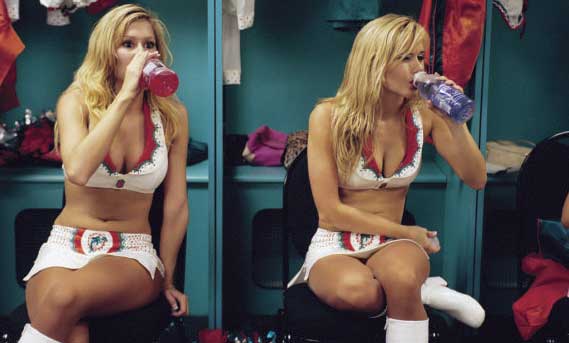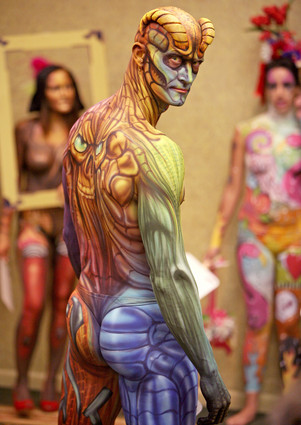Pop Quiz: One woman or two?
Or was it a trick question? There obviously are two women there, even if one is a copy of the other. And if you look closely, you can see small differences in hair or the accessories in the background or whatever else you want to pore over. But, of course, there also is only one woman there: a blond archetype of American femininity that is the model for each of these two Miami Dolphins cheerleaders.
The two bodies could almost be clones. And, of course, they are: not because they share a fair amount of genetic material, but because each is an near perfect copy of a social form. Each is identically styled to that conventional model, from physical training to gestural habits to costumes and make-up. Each will stand out because she so completely conforms to one set of social norms. Together they mirror not only each other but their society’s demand for conformity.
But don’t think that style is to blame. Or at least consider the other end of the spectrum:
There is only one of this guy, right? He is a model at the annual Face and Body Art International Convention. Who else could possibly look like this? (The style is the man.) But, of course, he is not so unique. He fits right into the body art subculture, and the artist is drawing on familiar conventions of mythic iconography and popular design. Just in case that context isn’t clear, notice the Mona Lisa figure in the left background. And, like the cheerleaders, his well-toned body is a standard typification of gender.
The cheerleaders train for hours to have a few minutes of spectacular performance, all at considerable cost to themselves and other women. Mr. Body Art is a model of self-fashioning, but only for a few hours in a convention center that tomorrow will be hosting Rotarians while he becomes just another guy on the street. Fashion alternates between conformity and unique self-assertion, and each depends on the other. Most of us spend our time between these two extremes, but we shouldn’t feel too smug about that. Among human beings, there are only differences of degree, never of kind.
Photographs by Abbey Drucker/VMAN Magazine (October 2008) and the Orlando Sentinel, and Vince Hobbs/Orlando Sentinel (2009).


this is an interesting entry, but the cheerleader example is not ideal for supporting your argument.
cheerleaders are part of sport team, and like the players on the field or court, they wear team uniforms. cheerleaders perform complex choreographed routines that often rely on a uniform height/weight/proportion of the individual performers (e.g., geometric formations; simultaneous moves; lifting/balancing performers). like ballerinas who are lifted by the male dancers, the social norm of what a typical ballerina “looks like” conforms to what is offered — namely thin and lythe ballerinas that are easily lifted, turned and otherwise manipulated by the male dancer). also, like ballerinas and other performers, cheerleaders put countless hours into practicing routines and dieting all for the purpose of being “on stage”.
furthermore, as you point out, the body painting fellow has a greco-roman-like physique, one that for most males is not easily obtained in today’s snack-food-obese-lazy-man-boy-x-box world. he, no doubt, puts in much time at the gym and in front of a mirror, not to mention the hours of being painted and all of this “conformity” to the male ideal has no negative impact on other males (and probably to no ill-effect on women). yes, his individualistic self-display of his unique “canvas” is very much in contrast with uniform and stereotyped female “ideal” that the cheerleaders have adopted, but under the paint he is communicating something about male physique and it could be argued that his body — his developed upper body, low body fat and anatomical symmetry — perfectly reflects society’s “ideal” male body — and again, at no cost to males in general.
women who support the cosmetic ideals of society, who inadvertently or intentionally support and reinforce cultural stereotypes of beauty, “normal”, and ideal, do promote conformity. it could be argued that today, more than ever, it’s “easier” for more women to “fit in” — the easy access to media portrayals of beauty (via a slew of new media devices and distribution systems as well as the exportation of Western notions of beauty and style world-wide), low-cost fashion “knock-offs”, affordable and ubiquitous cosmetic surgery, “make-over” culture including step-by-step self “improvement” programs and so forth. it should be noted that female performers only qualify for leading roles when they fit the social norm body-wise — BUT — they are lauded endlessly when they gain weight for a role or otherwise transform themselves AWAY from the cultural ideal — typically praised for being “brave”, talented or otherwise strong for moving away from from the “beauty” zone.
We cannot just say “The way I look is what I am” and ignore what others say or feel about our appearance. More than half of our body features can be perfected to be the part of an ideal body. Over ninety percent of the body features could be at least improved. Therefore we need not feel low and rejected. Usually what happens is we give up even without a try. Rather than being lazy and feel rejected is better to give a try and be satisfied with the outcome.
I like the visuals and the article. I don’t feel there are any strong points the writer is trying to make other than don’t be so smug, everyone swings back and forth between layers of conformity and uniqueness. It’s something we all do. refreshing thoughts.
am i the only one that is trying to see up her/their skirt(s)?